The 16th
LaureateArchitecture
Oscar Niemeyer
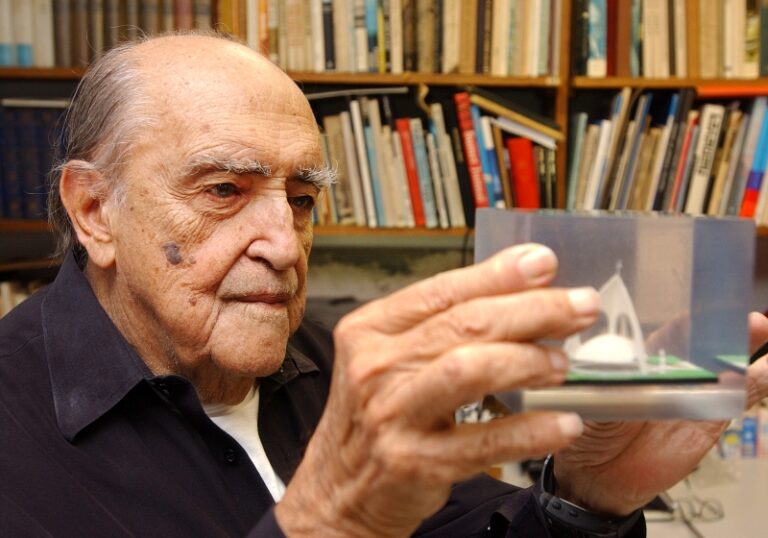
Oscar Niemeyer was born in Rio de Janeiro,Brazil in 1907. Niemeyer worked with Le Corbusier on the United Nations Headquaters in New York,and in 1957 was appointed to implement Lucio Costa's plans for Brazil's new capital,designing most of the city's important buildings. Niemeyer is recognized as one of the first to pioneer new concepts in architecture. He developed a fluid,sculptural style,using reinforced concrete to create dramatic structures that reflect the natural,flowing curves of Rio de Janerio’s mountains,beaches and bay.
Like his mentors,Lucio Costa and Le Corbusier,he was a Modernist,but his pursuit of great architecture linked to the roots of his native land resulted in new forms and a lyricism in buildings,not only for Brazil,but for the world. Niemeyer,now 96 years old,continues to work in his office. His most recent project,Oscar Niemeyer Museum in Curitiba,Brazil,opened to the public in late 2002.
Biography
Oscar Niemeyer was born in Rio de Janeiro,Brazil in 1907. He graduated from the Escola Nacional de Belas Artas in Rio de Janeiro in 1934,and then joined a team of Brazilian architects collaborating with Le Corbusier on a new Ministry of Education and Health in Rio de Janeiro. This proved a formative experience for Niemeyer. Niemeyer also worked with Le Corbusier on the United Nations Headquarters in New York.
Niemeyer’s fluid forms presented a poetic alternative to the straight lines and right angles of the international style,the principal trend in European modern architecture in the 1930’s. In 1942,Niemeyer created a series of recreational buildings that borrowed extensively from the expressive Brazilian Baroque style of architecture.
In 1956 he was appointed architectural adviser to Nova Cap - an organization charged with implementing Lucio Costa's plans for Brazil's new capital. The following year,he became Nova’s chief architect,designing most of the city's important buildings such as National Congress,Planalto Palace,Federal Supreme Court,Arcos Palace,Cathedral and Juscelino Kubitschek Museum. This epoch of Niemeyer's career and these buildings are landmarks of modern symbolism.
Niemeyer continued to work on Brasilia until 1964 when his political affiliation with the communist party forced him into exile in France. While in Europe,he constructed,among other projects,the French Communist Party Headquarters and the University of Constantine,Algiers. With the end of the dictatorship in Brazil in the late 1960’s he resumed his career in Brazil,teaching at the University of Rio de Janeiro and working in private practice.
Niemeyer is recognized as one of the first to pioneer new concepts in architecture. Niemeyer developed a fluid,sculptural style,using reinforced concrete to create dramatic structures that reflect the natural,flowing curves of Rio de Janerio’s mountains,beaches and bay. Like his mentors,Lucio Costa and Le Corbusier,he was a Modernist,but his pursuit of great architecture linked to the roots of his native land resulted in new forms and a lyricism in buildings,not only for Brazil,but for the world.
Niemeyer,now 96 years old,continues to work in his office in Copacabana,Rio de Janeiro. He looks quite healthy and physically strong at his age,and has yet many large projects to plan. His most recent project,Oscar Niemeyer Museum in Curitaba,Brazil,opened to the public in late 2002.
Chronology
Exhibition at the Louvre
Memorial to Latin America in Saõ Paulo
-
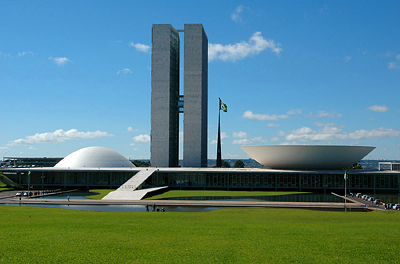
National Congress, Brasilia, Brazil 1958
-
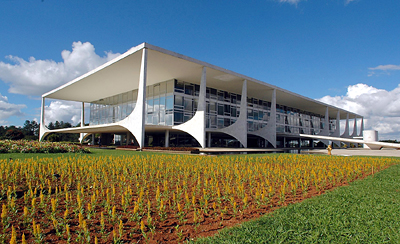
Planalto Palace, Brasilia, Brazil 1960
-
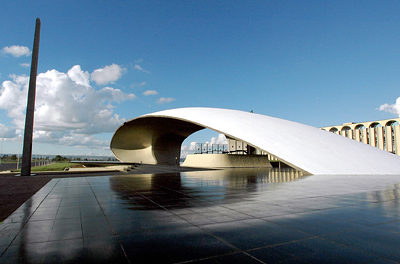
Military General Headquarters, Brasilia, Brazil 1968
-
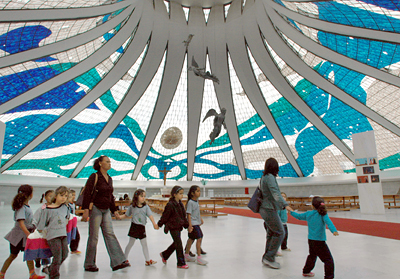
Cathedral, Brasilia, Brazil 1970
-
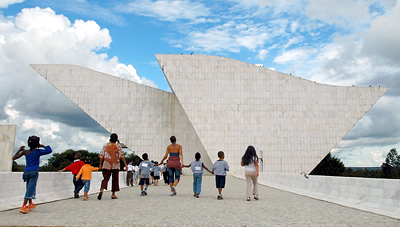
Tancredo Neves Freedom & Democracy Pantheon, Brasillia, Brazil 1986
-
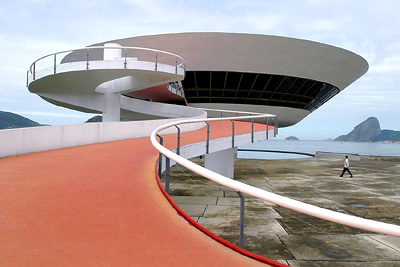
Niteroi Museum of Contemporary Art, Niteroi, Brazil 1996
-
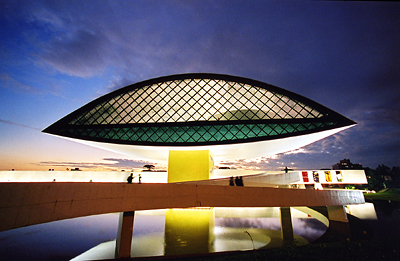
Oscar Niemeyer Museum, Curitiba, Brazil 2002
Lecture
Architecture Forum on Oscar Niemeyer
Kajima KI Building in Akasaka, Tokyo. October 22, 16:00-17:40.
Below is the summary:
Oscar Niemeyer, the Architect of Two CenturiesBy José Carlos Sussekind Oscar Niemeyer’s associate structural engineer
The Panteon’s dome in Rome, its juxtaposed blocks in stone masonry built up about 2000 years ago and the free spans of the Doge’s Palace main state rooms in Venice, supported by wooden trusses, completed at the eve of Renaissance, both erected in times when there was no mathematical or physical basis for structural calculations, are two major examples of the use of materials and consequent evolution on construction techniques in order to allow architectural creation and conquering-spans dreams to become true.
Recalling the architecture, worldwide, of last century first decades, strongly influenced by Bauhaus school, we can realize its relative mediocrity, its non-declared policy of hiding the structures almost completely, behind walls or coatings, as if they were a kind of a necessary evil, something necessarily ugly (and they really were...) inside the buildings that, in reprisal, became monotonous successions and repetitions of towed, painted boxes.
It was in that moment that Oscar Niemeyer appeared, breaking up with the dictatorial rules of the functionalism, introducing, as an innovation, as a goal in itself, the beauty and harmony of curves and asymmetric forms, bringing together a growing valorization to engineering solutions, the architectural creation working towards the total exhibition of the structures, taking advantage of its properties and proportions, harmonizing it in the whole. It was a revolution, indeed.
One can see, since his beginning, in 1940 Pampulha project, that this was reached: the cylindrical shells covering the church and the thin marquees whose projections followed the curved edge of the lake, were highlighted, thus becoming key- elements to assure beauty and equilibrium to the complex.
Shapes, lightness, thin, daring, apparent concrete structures: of these issues, Niemeyer would nevermore retreat in his almost 70 years career, in his more than 500 different projects ( one of them is the Capital of Brazil) already built.
-
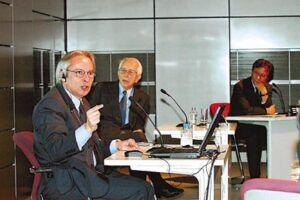 from left: José Carlos Sussekind, Maki Fumihiko, Miyake Riichi
from left: José Carlos Sussekind, Maki Fumihiko, Miyake Riichi -
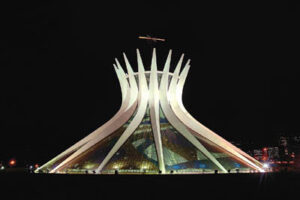 Cathedral, Brasilia, 1970
Cathedral, Brasilia, 1970 -
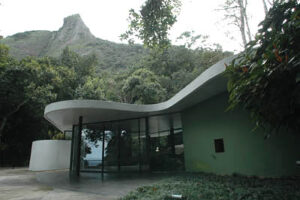 Niemeyer Residence on Canoas Street, Rio de Janeiro, 1953
Niemeyer Residence on Canoas Street, Rio de Janeiro, 1953
-
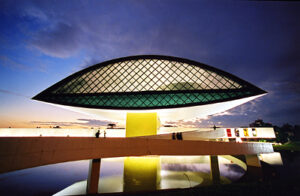 Oscar Niemeyer Museum, Curitiba, 2002
Oscar Niemeyer Museum, Curitiba, 2002
-
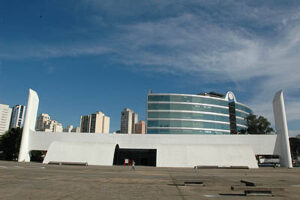 Memorial to Latin America - Library, Saõ Paulo, 1988
Memorial to Latin America - Library, Saõ Paulo, 1988
-
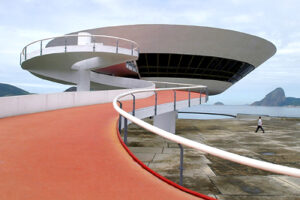 Niteroi Museum of Contemporary Art, Niteroi, 1996
Niteroi Museum of Contemporary Art, Niteroi, 1996
-
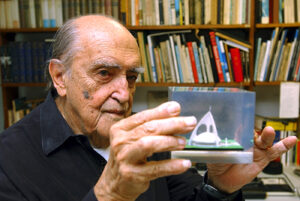 At his office
At his office
About one month ago, Oscar and a small group of friends, including myself, in our regular Tuesday’s night classes of philosophy were hearing about how different philosophers defined beauty. Oscar stood quietly, his eyes looking far away. And suddenly, gently, humbly, he made his statement: "I think there is real art when, and only when, 2 things are brought together: emotion and surprise". What a definition and how coherent it is with everything he did and does throughout his life! He likes to repeat: "When you visit one of my projects, you may like or dislike it , but never can tell you’ve seen an equal one before". That’s the surprise-issue, so important to Niemeyer as to Baudelaire, and so strangely unallowed in Classic Greece.
In spite of those who have had the tendency, on pretext of minimizing costs, of condemning everything that was new, audacious, everything that fled to the traditional canons, a step after the other it became no more a heresy to accept very thin slabs (1950- covering the famous architect’s house at Canoas, Rio), intensely reinforced columns ( 1958- facades of Presidential Palaces and Supreme Court in Brasilia), suspended buildings, having its main structures in the top ( 1968, Mondadori Palace at Milan, till 2004, outstanding Governor’s Building, recently conceived to the state of Minas Gerais), huge cantilevers and spans ( 1969, University of Constantine, Algeria, till 2004, Governor’s Building), in attendance to higher demands of beauty, surprise, functionality or plastic character.
The development of Niemeyer’s work is always and absolutely linked to the progress of reinforced and pre-stressed concrete technology. No other material would give him so much freedom in the instant of creation. Freedom that makes his creation unique, new, expression of our times, nothing having in common with old solutions of classic or neoclassic inspiration, dropped by the concrete, which has allowed everything and has changed everything. The material that brought a positive breakthrough into the architectural creation.
It is because we have tried to take good advantage on the potentiality of concrete, facing the limit- situations that Niemeyer’s creation in many cases imposed and still imposes, that we got some international respect, as a country, in the design and construction of structures. It is a historical example and landmark for us, particularly to myself, aged 22 at that time, the one of Constantine University, considered as structurally and constructively impossible by some European experts at the end of the 60’s and, notwithstanding, designed and erected without major difficulties by Brazilian engineers and contractors.
Niemeyer’s artistic personality is clearly noticed along the common work with the structural engineer, during the early creative process: Oscar shows his first sketches, explains what is important, in that case, in terms of spans, shapes and free volumes. The chat continues in the search of the best structural configuration, followed by my preliminary ( which always has to become final...) determination of the basic dimensions. The very fascinating to testify is that, rarely these chats do last more than 20 minutes, even in very big projects and -still- in the great majority of the cases, the proportions drawn as attempts in Oscar’s first sketches prove themselves, at the end, to be those technically more feasible and advisable. An instinctive, artistic, uncommon sense of what the structure will need.
Oscar works very, very, quickly. He sketched Pampulha in one night; that was the schedule imposed by Mayor Kubitscheck. As a reward, a friend for all life, who charged him of all buildings of the new Capital, once he became President of Brazil, 15 years after. National Theater in Brasilia was conceived in a weekend. Algiers Mosque came, "ready", to his mind when he was going to bed; he returned to the table and registered it in 5 minutes. Niteroi Art Museum, considered by some publications "one of the 7 marvels of modern times", was drawn in a napkin at a small bar, the other side of the site, while he waited for the fish he had ordered.
Oscar will be 97 years old next December. His health is blessed. As if the gods themselves took the charge of protecting such an artistic genius, such a humanist. His mind is the same of someone of my age. He works 7 days a week; we have more than 10 different projects, in different regions, now under development and construction. The National Museum and the National Library in Brasilia, the Government Buildings in Minas Gerais, the Sea Museum -suspended over the sea- in Ceara, the Niemeyer Way in Niteroi, Itaipu headquarters, a Monument to Peace in Paris, a New University in Brasilia, Bolshoi School of Ballet in South Brazil and , probably, a new one I will be told when arriving back in Brazil.
There is nothing similar in all times. Perhaps Picasso produced as much as Oscar; but not till such age and not dealing in an activity with so many technical interfaces. Oscar is a lesson of live. He , who probably built more than any other architect, has kept no money to himself. And is particularly proud of it. He shares everything he earns with his family, his friends, with someone that needs and asks him for help or causes he welcomes. He works each day to earn his living. He is still a major activist, an enemy of prejudice, violence and war.
He is, undoubtedly, a living myth. One of the soles. I’m sure he fully deserved the honor of the Praemium Imperiale , granted by The Japan Art Association. Honor that pleased and touched so much a man of his simplicity. Honor once more I thank on his behalf and in name of all Brazilian country fellows.

